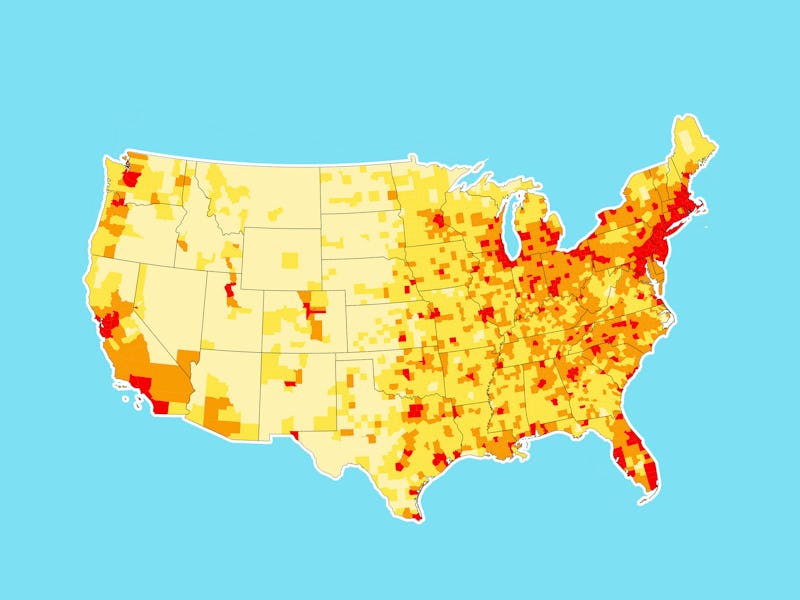What a 2050 Population Prediction Says About the Future of America
When 70 percent of America lives in 15 states, how will we pick presidents?

For the better part of a decade, various forecasts from the United Nations and U.S. Census Bureau, among other data-analyzing organizations, have been predicting that if trends continue, nearly three-quarters of the world’s population will live in urban areas by the year 2050.
The statistic could signal a myriad of changes for the country, from transportation to healthcare to security to pollution, but the election of Donald Trump has the authors of a new book viewing the stat squarely from a political point of view. Namely, has America’s government not kept up with the country’s transition from an agricultural society — where the population was spread far and wide — to an urban one, where most people live in metro areas?
America’s political system was created for a country with a more even distribution of the rural and urban population, says journalist E.J. Dionne, who co-authored One Nation After Trump with Norman Ornstein, a resident scholar at the American Enterprise Institute, and Thomas Mann, a resident scholar at the Institute of Governmental Studies at the University of California, Berkeley.
“I think it’s by 2050 — 70 percent of Americans will live in 15 states. That means that 70 percent of Americans will have 30 senators, and 30 percent of Americans will have 70 senators,” Dionne told Fresh Air host Terri Gross this week in an interview. “The Senate, which unfortunately is very hard to change the way it was written into the Constitution, radically underrepresents populous states. And it does so more now than it used to. The ratio when the republic started between the smallest and largest state was 13 to 1. Now it’s around 70 to 1 or more.”
Of the 323 million people living in America, according to July 2016 estimates, 10 states have 51 percent of the population but only claim 20 percent of U.S. Senators. As population shifts toward urban areas, clustering more people into specific states, more and more of the country will be represented by a smaller number of lawmakers. The 20 senators from California, Texas, Florida, New York, Illinois, Pennsylvania, Ohio, Georgia, North Carolina, and Michigan have the same voting power to laws as those from Wyoming, Vermont, Alaska, North Dakota, South Dakota, Delaware, Montana, Rhode Island, Maine, and New Hampshire.
Out of the 538 electoral college votes across the country, the 10 most populous states — that 51 percent of the population — have just 44 percent of the electoral votes (240) that, as shown in the November election, can determine the presidency. The number of electoral college votes each state gets depends on the number of congressional representatives, plus two for each senator; the number of electors per state is added or reduced every 10 years according to the U.S. Census.
The red areas have 250 people per square mile, the orange 50-249, the yellow 10-49, and the light yellow less than 10.
The authors make the case that a future America could be what they call a “non-majoritarian democracy,” meaning the popular vote, which has traditionally synced up with the electoral college vote, is trending in the opposite direction.
“Since 2000, we have already had two elections in which the Electoral College votes out of sync with the popular vote, and this time, the biggest gap in the popular vote we’ve ever had in such an election,” Dionne told Gross in that NPR interview. “And I think that speaks to the fact that the country is reorganizing itself. And more and more Americans are moving into metro areas.
“The overrepresentation of non-metro America in our system is becoming even more profound,” he says.
From there, the book’s central message is about how America should consider eliminating the Electoral College in favor of a straight-ahead popular vote.
Trump’s election has galvanized not just his political opponents, but those who question whether the Electoral College has become outdated as population shifts toward cities that that that give electors an unfair advantage, it results in presidencies decided not by the popular vote but by the Electoral College.
The book argues against Trump’s political ideas and crass behavior, but its most interesting message seems to be that his election is the craziest example yet of a broken system. George W. Bush didn’t win the popular vote in 2000 but won the electoral vote 271-266. Two times in the last 17 years the popular vote hasn’t mattered. And this kind of an electoral win only ever happened three times before the 2000 election.
In all of American history’s 58 presidential elections, only five times has the winner not won the popular vote. The first three happened in the 1800s — 1824, 1876, and 1888 — and they were unorganized, fractious, controversial events that occurred long before the accountability we have in place today.
There are a number of factors contributing to the Electoral College being more powerful than ever. The act of “gerrymandering” — strategically drawing up congressional districts based on the voting records of the people who live there — results in amoeba-shaped districts, and winners of those districts determine the person who will be an electoral college voter. The selection of the president by an elector becomes more about political strategies than the popular voting results.
“If Trump is a threat to our democracy and the product of its weaknesses, the citizen activism he has inspired is the antidote, the way to vindicate our long experiment in self-rule,” the authors write.